Fish of the Great Barrier Reef
Damsel Fish
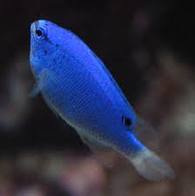
Damselfish: Usually gather in large schools, hovering above the reef and feeding on plankton. You quite often see a school above a large head of staghorn coral and just by the snap of a finger they will all dart into the safety of its surrounds. They range in size from approx 6cm to about 14cm. Even though they are quite small they can be quite brave. The common male Farmer Damsel will dart out at a diver, taking many swoops at you as a warning to stay clear of his nest of eggs. He will bite which feels rather like being pinched.
Wrasse

Wrasse: These amazing fishes can change sex from female to male. They are very colourful and feed on small invertebrates. They usually live on the bottom or mid water and get around in small groups or pairs with the male dominating. They do not care for their eggs, which rise to the surface. Many a dive sight has the friendly Maori Wrasse waiting to greet you, and quite commonly he will be called Wally? The small species in the family are approx 10cm and some species can grow up to a monestrous meter in length.
Butterfly Fish
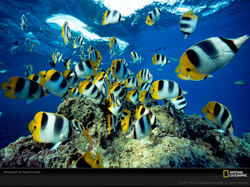
Butterfly Fish: These beauties are well renowned for their gorgeous colours and patterns and their graceful beauty whilst swimming. They feed on live corals and when they find their partner it is a lifelong bond. The average butterfly fish is approx 12 -14 cm but some of the larger grow to about 25cm.
Angelfish

Angelfish: These fish are closely related to the butterfly fish and are in some ways just as beautiful. They feed on sponges and small invertebrates. The larger in the species will produce a large drumming sound when it is agitated. Sizes are from approx 10cm up to 35cm.
Cardinal Fish

Cardinal Fish: A little like the damsel however the Cardinal is nocturnal. He hides in coral formation and caves and crevices during the day and comes out at night to feed on small shrimps and crabs. His colours are quite subdued, and his eyes are quite large. The male fertilises and cares for the eggs inside of his mouth. They are a small species with sizes from 6cm to about 12cm.
Gobies

Gobies: Another bottom dweller, which are scattered all over the reef, they are in fact the most abundant of the fishes. So you don't miss them look closely at the surface of corals rocks and sponges as well as in the sand and rubble. Like the Blemie they also look after their eggs. They are usually only 4-5cm in length.
Triggerfish
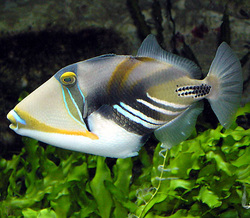
Triggerfish: In the summer months Triggerfish get busy building their nests in preparation for the laying of their eggs. To make their nests, the Triggerfish lay on the sandy ocean bottom and blow water out of their mouths to create a small crater. They clean the sand of any rubble by picking it up with their teeth and discarding it over the edge. The Trigger fish lay their eggs on the bottom and become fiercely protective of them. The eggs resemble a clump of small bubbles. Divers are strongly encouraged to stay away if they see a nest as the Triggerfish may become aggressive in their nature if they feel their eggs are in danger. This change in behaviour for the normally docile Triggerfish will last for about two or three months so all divers beware. Triggerfish are characterised by cone-shaped heads with eyes set far back from the mouth and well-developed dorsal and anal fins. Tritan triggerfish can grow to 50cm and are powerful. Luckily the breeding season is limited to summer.
Clown Fish and Anemone
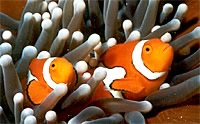
Anemone or Clown Fish: These beautiful fish is by far the most photographed fish of the sea. Their dainty, fun and playful movements fascinate divers and snorkellers the world over. The Great Barrier Reef is no exception. When hearing a dive brief on a particular site the Dive Master will always point out where the Anemone is situated and it is here you will find them. The fish have a close association with the anemone; they nestle down into the host's soft fleshy tentacles and acquire immunity from their deadly stings by slowly covering themselves with a layer of mucus from the anemone. Initially they get stung but once they have enough mucus on them the anemone assumes it is only touching it's own tentacles. If the fish leaves it's host for a day or so it loses it's immunity and must rebuild its coating. The fish is safe from predators in its host as they will be stung if they venture too close. Anemones generally like shallower places and attach themselves to hard corals. When you come across them, stay a while - the clownfish antics will really delight you.
Parrotfish
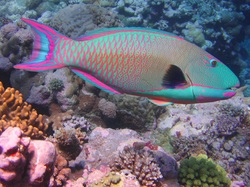
Parrotfish: These guys are closely related to the Wrasse, and are spotted and clearly heard scraping the algae from the coral. When they do this their beaklike mouth consumes quite large amounts of the coral, which is ground up and discarded with their faeces. It is quite a common sight to see powder like substance coming from them when they dart around. Young Parrotfish and females are drab next to beautifully coloured males. However they are able to change from Female to Male when needed. The parent does not care for the eggs. Their average size is 20 to 30 cm however some species can grow up to around 100cm.
Plants of the Great Barrier Reef
Brain Coral

Brain corals are found in shallow warm-water coral reefs in all the world's oceans. They are part of the phylum Cnidaria, in a class called Anthozoa or "flower animals." The life span of the largest brain corals is 900 years. Colonies can grow as large as 6 or more feet (1.8 m) high.
Fan Coral
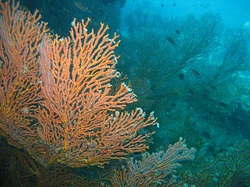
A gorgonian, also known as sea whip or sea fan, is an order of sessilecolonial cnidarian found throughout the oceans of the world, especially in the tropics and subtropics. Gorgonians are similar to the sea pen, another soft coral. Individual tiny polyps form colonies that are normally erect, flattened, branching, and reminiscent of a fan. Others may be whiplike, bushy, or even encrusting. A colony can be several feet high and across but only a few inches thick. They may be brightly coloured, often purple, red, or yellow. Photosynthetic gorgonians can be successfully kept in captive reef aquariums
Fire Coral
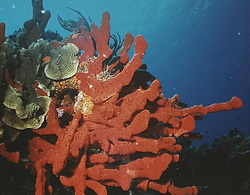
Fire corals have a bright yellow-green and brown skeletal covering and are widely distributed in tropical and subtropical waters. They appear in small brush-like growths on rocks and coral. Divers often mistake fire coral for seaweed, and accidental contact is common. Upon contact, an intense pain can be felt that can last from two days to two weeks. The very small nematocysts on fire corals contain tentacles that protrude from numerous surface pores (similar to jellyfish stings). In addition, fire corals have a sharp, calcified external skeleton that can scrape the skin.
Red Algae

often found growing under kelp forests or in low light conditions
Green Algae
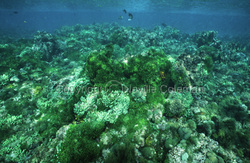
often found in shallow waters such as the tops of reefs or rockpools
Brown Algae
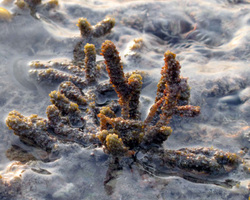
the group that includes kelps as well as a large number of smaller species found on rocky shores.
Sea Grass
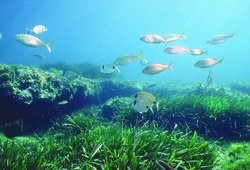
The seagrass beds are flowering plants. These provide shelter to sea creatures such as the conch or the lobsters. Tiny organisms are also known to live in their leaves. The rhizomes or the stems of the sea grass (with roots attached) anchor the plant. They also keep the seawater clean as they trap large amounts of sediments. They play a very important role in preventing beach erosion.
